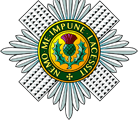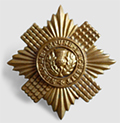During the Second World War the principal centres of attention for the Scots Guards were North Africa, Italy and the moves through France, Belgium, Holland and Germany in 1944 and 1945 until the German surrender. The same arrangement for Battle Honours on the Colours was followed again. In 1939 the 2nd Battalion was already stationed in Egypt. Early on the Italians were the only enemy, but when they were badly defeated and there was a risk of their being expelled from Libya the Germans intervened. In 1942 the Afrika Corps came into being, well equipped, trained and motivated and led by General Rommel. In one of the subsequent battles the 2nd Battalion, in the 201st Guards Brigade, held the Knightsbridge Box for two weeks under heavy attack, but because of other events nearby it was a severe British defeat. The Battalion’s casualties were at a comparable level to a battle in the First World War and they won the Battle Honour “GAZALA”. The British withdrew to the Alamein position along the Egyptian border, which they held successfully ahead of the counterstroke at the Battle of Alamein. Revenge for Gazala came in March 1943 by which time the British were approaching the Tunisian border. General Rommel staged a major counterattack and, having just moved up to the most forward positions, the 201st Guards Brigade’s anti tank guns destroyed the German tanks at point blank range in large numbers, resulting in the important Battle Honour “MEDENINE”. Apart from participation in the abortive campaign in Norway in 1940 the 1st Battalion was still in Britain. Late in February 1943 they embarked on board ship, destination unknown, but it was to North Africa. By this time British and American troops were well into Tunisia. The last German line of defence was in rough, rocky hills (“djebel” in Arabic) twenty five miles from Tunis itself. The 1st Battalion, now in the 24th Guards Brigade, fought for two weeks here, suffering very heavy casualties, with thirst also a great strain. The Germans fought hard and the approaches to their positions were across the open, without any cover. The main objective of the 1st Battalion was a prominent outcrop dominating their area, nicknamed “the Bou”. On 27 April the advance was obstructed by a German machine gun post and by an 88mm gun position close by on the flank of the Bou. Only Captain The Lord Lyell with four men were in the right place to do something about it. First they attacked the machine gun post which Lord Lyell demolished with a grenade. One of his men was then killed and the other three wounded, though two were still able to fire to support him. Lord Lyell dashed at the gun position across the open, killed most of its crew before being killed himself and was awarded a posthumous VC. The German positions at the Bou finally fell on 5 May. The Battle Honours “DJEBEL BOU AOUKAZ, 1943, I” and “NORTH AFRICA, 1941-43” were added to the Colours.
It was in North Africa that Colonel Archie Stirling of the Scots Guards formed and had the ideal conditions to carry out raiding operations behind the enemy lines with the Special Air Service Regiment.
The 2nd Battalion took part in the landings at Salerno on 9 September 1943. Initially, there was a disturbing lack of opposition, but why became apparent as the British and the Americans, further south, moved inland. The Germans had deployed small parties, well concealed in scrub and ditches, to snipe from behind the advancing troops. The 201st Guards Brigade then came across a large agricultural complex at Battipaglia, which, on the only German communication route behind their positions, was of critical importance. The fighting was intense as both sides attacked and counterattacked and the casualties reflected it. The Allies just managed to hold onto what they had along the coast but it was a very close call before the enemy pulled back in the face of heavy bombing and shelling by the Royal Navy. A crewman on a landing craft said to a wounded Scots Guards officer he was looking after that he had heard that things were not going well ashore and asked him which Regiment he was in. On being told he said “I reckon we’ll be O.K. if the Guards are there.”
The British and American Armies advancing from the south of Italy joined up with those at Salerno and, as the autumn wore on and the conditions worsened, slowly and painfully moved on from each deep river valley across each mountain range beyond. The 2nd Battalion’s next major battle began on 5 November and was finally concluded on 9 December, a grim and gruelling fight up steep rocky slopes on thoroughly prepared German positions. The main hill, with three high points and a monastery on the top, gave its name to the Battle Honour “MONTE CAMINO”. Thereafter the struggle went on through the winter until the 2nd Battalion went home in March 1944.
In an attempt to speed matters up there was a plan to break into the German defences from behind by landing at Anzio just south of Rome. On 22 January 1944 the 1st Battalion was in this seaborne operation by both British and American troops. The problem at Anzio was that shortage of landing craft made it impossible to land a large enough force to give the American commander the confidence to land and advance rapidly to cut the main German supply route twelve miles inland. Instead he went for consolidation of the landings, so the Germans had time to regroup and counterattacked in force over the coming weeks. There was nearly a disaster. Nothing but the most desperate fighting, with casualties comparable to a prolonged First World War battle, enabled the British and Americans to hang on. On 2 March the 1st Battalion was evacuated with a total strength of 238, having lost 666 all ranks, a third of them missing, mostly captured. The other two Battalions in the 24th Guards Brigade had suffered similarly. Scots Guardsmen should look at the Battle Honour “ANZIO” with particular respect. The 1st Battalion fought in Italy till the end of the War by when half of all Scots Guardsmen who lost their lives had died there, the Battle Honour “ITALY, 1943-45” being their memorial on the Colours.
Well ahead of the invasion of Normandy that began on D Day, 6 June 1944, the 6th Guards Tank Brigade formed in England and included the 3rd (Tank) Battalion Scots Guards, equipped with Churchill tanks. On 22 July they landed in France and would serve from then on mostly attached to the 15th (Scottish) Division. Their first battle in Normandy was the assault on a long ridge, known usually as the Battle of Caumont, but for which the Battle Honour “QUARRY HILL”, part of the ridge, was awarded. The 3rd Battalion continued on into Belgium, Holland and finally Germany, the other Battle Honour attributable to them after the crossing of the frontier, but shared with others, being “RHINELAND”. Since leaving Italy the 2nd Battalion had been reinforced, including with a large detachment of men transferred from the RAF, and trained for infantry operations in the Guards Armoured Division which it joined early in February 1944 and fought with to the end of the War, ending up near Bremen. Almost immediately after their arrival the 2nd Battalion in the Guards Armoured Division and the 3rd Battalion again with the 15th Division were in from the start in the Battle of the Rhineland. It was very cold, but that it was so wet was worse over terrain of large easily defensible woods, low lying farmland and fortified villages. The enemy had withdrawn across the Rhine by mid March. In the operations to cross the Rhine and subsequently the 6th Guards Tank Brigade were for a time working with the Americans following which the Brigade Commander received a message from General Matthew Ridgway, Commander of the US Airborne Corps, later the Supreme Allied Commander in Europe “The period of our joint service has been brief but includes momentous days in a brilliant and now historic operation [the Rhine crossing and the advance to capture Műnster]. The contribution of 6th Guards Armoured Brigade in the success of the whole operation has been conspicuously superior. On the occasions I have been privileged to mingle with elements of your command, I have felt at once that atmosphere, that intangible something almost physical, which only the finest troops create. I am deeply conscious of having had these incomparable troops in my Corps. I should like to express to you my appreciation of your unfailing and complete cooperation, and my high respect for your professional abilities and leadership.” Just after the German capitulation in May the 3rd Battalion had the unusual role of boarding and taking the surrender of a German submarine on the Baltic coast. The final Battle Honour was “NORTH WEST EUROPE, 1944-45”


